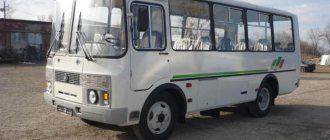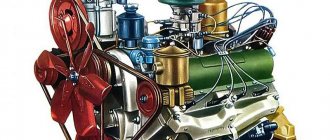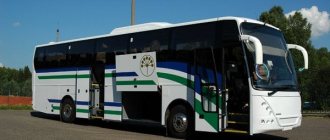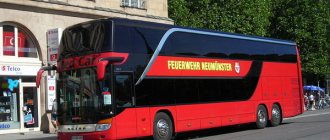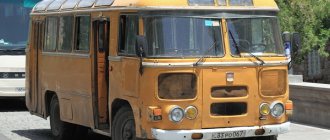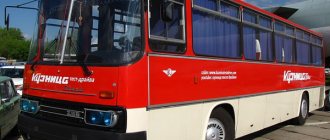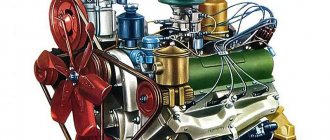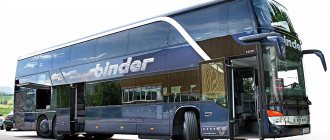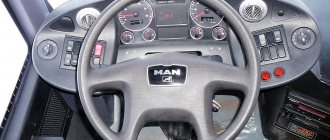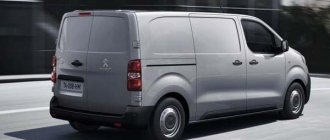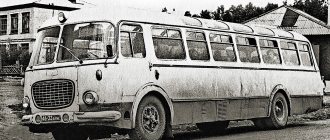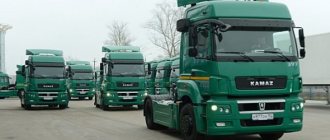Home page » Buses » Manufacturers » SETRA
Bus MultiClass S 415 LE. Setra Photos
Small and large enterprises operate successfully in the German bus manufacturing market . It is the leading companies and the equipment they produce that attract special attention. The industry leaders in Germany are several companies : Neoplan, Mercedes, MAN, as well as Setra, which is discussed below. This article provides basic, general information about the manufacturer and Setra buses. Detailed information about some models is collected in separate publications, links are provided in the text.
Who is the manufacturer, country and more
Setra Omnibusse is a large German manufacturer of buses for various purposes and bodies for tourist models. The company, located in Ulm, was founded in 1911 and was called Karl Kassbohrer Fahrzeugwerke GmBH . In 1951, the first bus, designed by Otto Kassbohrer, was released and had two features: a load-bearing body and a spatial power welded frame made of steel profiles, which gave the name to the brand - SElbsTRAgende (which means “self-supporting body”). This type of design is the basis for a large number of modern machines.
Setra S8 bus. Photo Wikipedia
In 1967, the 100th series of buses was introduced , which marked the transition of the enterprise to a new level of development. The family collected all the innovations of that time. The first double-decker bus was assembled in 1982, it was S228DT . New standards in the field of comfort and design were set by the 300th series of Setra models , presented to the general public in 1991. Since 1994, the manufacturer began using the stylized letter “K” as its logo. In this way, the company paid tribute to its founder, Karl Kassbohrer.
In 1995, Setra, together with Mercedes-Benz Omnibusse, formed the EvoBus GmbH group , which is now part of the Daimler AG concern. In 2001, serial production of the Topclass 400 family of vehicles began, the models of which were distinguished by a modern design, improved aerodynamic parameters, and a lightweight body. In 2012, the company began production of the 500 series, the first model of the family was the Setra Comfort Class 500 , in 2014 the Top Class 500 was introduced. Setra is known and respected in the segment of production of premium intercity and tourist buses.
Setra buses are 70 years old - what is the history of the brand?
Lots of cargo anniversaries this year! So the Daimler concern decided to celebrate an unusual round anniversary - seventy years of the Setra bus. It is unusual in that this well-known name in the bus world appeared as a proper name for the cars much later than the appearance of the owner company.
Touring Kässbohrer 1936 with a sliding roof and its own name "Silver Bird" on a Mercedes truck chassis
Back in 1893, a young carriage maker, Karl Kässbohrer, founded his own carriage workshop in Ulm. And in 1907 he built his first bus on a Saurer chassis - very unusual. It was actually a truck, the sides of which were transformed into bench seats (soft!). On weekdays he delivered beer around the city, and on weekends he turned into a walking bus with a canvas awning instead of a roof. Subsequently, buses became the main (although not the only) activity of the family company.
The prototype of an articulated city bus on a MAN chassis did not go into production
By the mid-1930s, the Karl Kässbohrer company had become a reputable bus manufacturer. Like many others, it built “passengers” on truck chassis, in this case mostly Mercedes. The then young line of tourist buses played an important role in the program. The company paid special attention to passenger comfort. Even then, soft chairs with height-adjustable headrests appeared, and sleeping chairs could now not only be folded out, but also moved apart.
One of the last Kässbohrer buses on a cargo chassis. The signature detail - the letter K on the rims - remains to this day
A qualitative leap occurred in 1951, when the name Setra first appeared. Already the son of the founder of the company, Otto, together with the chief designer Georg Wahl, developed his own design of a self-supporting body. It is from this word (in German “selbsttragend”) that the name of all buses comes from. Using new technology, the S8 model bus was assembled, which laid the foundation for all future generations. It was lighter, stronger, and therefore safer than its competitors. In addition, it was possible to use the interior space more efficiently and create more comfort for passengers. From that moment on, truck chassis ceased to be an indispensable basis for buses all over the world.
Here it is - the first self-supporting body of the future first Setra
Four years later, the compact Setra S6 bus was shown at the Geneva Motor Show. Its advantages lay in even less weight: the outer skin was made of aluminum, the windows on the rounded roof were made of then fashionable plexiglass. Both axles had independent suspension, which improved the smoothness of the ride. The choice of engines and gearboxes was wide, at the request of the customer. Later, a whole line of standard machines with a length of 7 to 12 meters appeared, bearing designations from S10 to S14.
The bus of the first series still has a light silhouette
By that time the company had gained worldwide fame. It is no coincidence that in 1956 Setra received a large order from the American company Continental Trailways. Among the two hundred vehicles, there were four unique ones - four-axle articulated buses 18.3 m long with their own name Golden Eagle.
The most luxurious intercity bus in the USA of the 50s - “Golden Eagle” with a Rolls-Royce engine
In 1967, Setra buses were modernized, forming the 100 series. In the future, the first digit will indicate the generation of vehicles built on a common base using a modular principle. In the cargo world, Scania professes the same ideology.
Interior of tourist Setra in the early 1970s
In 1973, a one-and-a-half-story “tourist” with a height of 3.55 m of the future S200 series was shown again in Geneva. Travel agencies liked it very much due to the presence of not only a toilet, but also an on-board kitchen on the ground floor, as well as a huge trunk.
Seven-meter machine 200 series - a convenient solution for the historical center
The car also had technical innovations: glued glass, disc brakes and air suspension. The bus was powered by a Mercedes ten-cylinder V-shaped diesel engine with a power of 320 hp. coupled with a ZF six-speed manual transmission.
The slash on the side of the 400 series is a sign of La Linea's signature design ("the line")
The next series of Setra buses, number 300, was launched in 1991. The entire model range from this generation was divided into three classes: urban MultiClass, intercity ComfortClass and tourist TopClass. This series received heated electrically adjustable mirrors as standard.
The most famous Setra in Russia is the “Russian Prince” from Kolomna, Setra S417 GT-HD
And four years later, the Karl Kässbohrer Fahrzeugwerke company formed the EvoBus alliance in alliance with the Mercedes bus department. Already being the luxury division of the global concern, in 2001 it introduced the next S400 series, which included more than 20 models.
Setra's latest series, the S500, was introduced in 2012 after four years of development and has been in production since 2014.
The second generation sets are actively used in Kaliningrad
And Kaliningrad must be recognized as the most “Setrophilic” city in Russia. One of the local passenger carriers is clearly in love with this brand - and therefore on the streets of the city you can see cars of different generations and models in abundance, and in very good condition.
Advantages and disadvantages
The manufacturer's philosophy is to use modern technologies and adhere to the highest quality standards in accordance with comfort, design, and equipment. The goal of the company is to produce the best product and provide quality service. As a result, Setra buses have a wide range of advantages:
Individuality. Each Setra bus has its own characteristics. A comfortable tourist bus, a functional regular bus, a spacious city bus and a specially equipped bus for a specific use profile - the manufacturer brings to life almost any customer requirements.
Setra MultiClass buses: S 415 LE business and S 418 LE business. Setra Photos
Safety. The company sets high safety standards in production, as it feels responsible for people. Company employees always use all possible means to protect the driver and passengers.
Profitability. Long intervals between maintenance, low fuel consumption, long service life of all units and machines.
Caring for the environment. Reduced diesel fuel consumption, responsible attitude towards the environment, confirmed by the Blue Angel insignia.
Comfort. Setra buses, regardless of their destination, provide a high level of comfort; models for long trips are especially convenient thanks to high-quality, individually selected and recreated equipment.
Design. The choice of external and internal design is an important advantage. Customers are provided with cars with interiors in different styles: from strict and discreet to completely exclusive.
The above advantages are the positive characteristics provided by the manufacturer himself . If you read the reviews of passengers, drivers and owners, you can note their high ratings in terms of convenience, quality, safety and reliability . The advantages of individual cars are their excellent driving performance and handling, low maintenance costs, and attractive design.
Setra S517HDH bus interior. Setra Photos
The main disadvantage of all high-quality buses, which have a number of advantages, is their high cost . Setra equipment is no exception. Despite this, buses are in high demand and trusted by customers from different countries. In this case, the advantages completely outweigh the disadvantages.
Comfortable climate
It turned out to be easy to create a comfortable temperature in a cozy cabin: after the engine warmed up, the Heizung and Lüftung (German - heating, ventilation) handles, fixed by a gear sector, responsively responded to the wishes of a noisy company of connoisseurs who filled the car for a long educational ride in the city surroundings.
The microclimate of human communication between the drivers and passengers of this unusual flight was also excellent. In (German – don’t talk to the driver) the jokers covered the word “nicht”, which is why the exchange of impressions quickly gained emotional momentum, which is difficult to do without when studying such a multifaceted retro...
But it’s all about the quality of the restoration, and it’s hard to find fault with it here, since it’s factory-made. Daimler AG, whose division is Setra, is known not only for the level of technology, but also for the ability to present it, and not only at a theoretical level, but in the format of excellent and useful practice. I understand how difficult it is to implement this, to literally translate it into metal, glass, plastic and rubber, and even more difficult when we are talking about technology that is 60 years old. With respect and gratitude, I shake hands with the team of specialists who managed to do this!
Model range, types
Throughout all the years of its successful activity, the manufacturer has offered a number of types of passenger transport. Different in purpose (urban, suburban, intercity, tourist), number of floors (standard one-story, one and a half with excellent visibility, and interesting in design two-story), level of comfort and equipment options (standard, increased comfort and luxury cars), engine location (prevail rear-engine) and floors (low-floor and high-deck), number and type of doors, volume of the fuel tank and luggage compartments.
Bus Setra S431DT. Photo Wikipedia
The Setra model range is analyzed in a separate article by providing the main technical characteristics of the most popular buses.
Popular brand models
Despite the diversity of the model range, some Setra machines are of increased interest to Internet users, in particular:
- buses of the 200 series were distinguished by many technical innovations of that time, which determines the attention to some models, in particular with the index 215;
- Setra 315 - a line that includes several (or, more precisely, 9) models for different purposes, is part of the 300 family, which was released in the 1990s;
Movement in space and time
Slow acceleration is not the main thing in this bus! You understand this when you see the sky and treetops through transparent, but at the same time durable walls and ceilings. By the way, during the rain, I noted that, despite its advanced age, not a drop of water got into the cabin. Elegant armchairs, beautiful lampshades, a chrome control panel along with a unique overview and the quiet sound of an old radio give that same feeling of moving in space and... time. Other road users, noticing this miracle on the road, not only pamper you with attention, prudently give way and patiently wait for the elegant sky-colored car, smoothly tilting, to complete the next turn.
The brakes and steering are also smooth and unhurried, but extremely informative and clear - you feel the reaction of the controls intuitively, merging with the car into one whole after a couple of tens of kilometers. I shared these thoughts with an elderly German specialist who accompanied us on the trip. In response, he gave me a quote from one of the famous factory testers of this bus, Stefan von Schenasy: “The car has unprecedented maneuverability when cornering, does not show a tendency to sway even on unpaved country roads and is not prone to unpredictable behavior, holds the road well. High-quality brakes provide a reliable margin of safety.”
Technical characteristics of the Setra S6 bus
| Length, mm | 6700 |
| Height, mm | 2630 |
| Width, mm | 2250 |
| Passenger capacity, persons | 24+2 |
| Wheel formula | 4x2 |
Engine:
| Henschel 517 D 4K Diesel, 4 cylinders in line 90 |
Transmission:
| ZF, mechanical 5/1 |
| Suspension | Front independent, multi-link, rear torsion bar |
| Year of construction of the tested bus | 1958 |
| Tire size | 7.50R16C |
Specifications
Studying the technical characteristics of buses facilitates the process of choosing the right model for a specific buyer, i.e. machines with optimal characteristics. Therefore, a separate article presents the types of Setra equipment in accordance with external (body dimensions, interior capacity, color schemes, etc.) and internal (type, model, engine characteristics, gearbox, and more) parameters. Familiarization with the information will allow you to understand how wide a list of buses the company offers, structure the information, make a choice and buy a bus.
Bus Setra S517HDH. Setra Photos
Slow acceleration
The first gear is very short: as soon as you start moving, it is almost impossible to stall even without getting used to the car; acceleration in subsequent stages is smooth, but far from explosive - 90 “horses” for almost 4 tons (exactly 3900 kg) curb weight and a dozen passengers do not contribute to high dynamic performance. You have to be careful with fifth gear: even before a slight climb, it’s better to switch to fourth so as not to upset the car, but on flat straights we quite confidently accelerated to almost 100 km/h. To help the driver, the speedometer is prudently marked into the operating zones of the corresponding gear - convenient!
Competing companies
Setra's competitors include primarily other leading German companies. Major market players are Neoplan, known for a large number of non-standard solutions and models in its range, Mercedes and MAN, which, despite having a common organizational structure with Setra, is often considered separately.
In addition, it is possible to note other leading enterprises in the industry:
- Van Hool and Jonckheere (Belgium);
- Volvo (Sweden);
- Dennis Specialist Vehicles and its successor Alexander Dennis (England and Scotland respectively).
It is also possible to list some European and Asian countries in which world-famous enterprises operate: Poland, France, Holland, Spain, Ukraine, Italy, Hungary and China, South Korea, Turkey. Don't forget about American manufacturers.
Where can I buy
Setra buses are sold both directly by the manufacturer and by supplier companies. Some companies are collected in the corresponding section of our website. Favorable rental and leasing conditions are offered by companies collected in the relevant sections of the site. A popular option among customers is the re-equipment of vehicles; companies are listed here.
SETRA, Small buses, Large buses, High floor buses, City buses, Double decker buses, Rear engine, Tourist bus brands and models, Intercity buses, Low floor buses, Single buses, Extra large buses, One and a half decker buses, Suburban buses, Articulated buses, Sleeper buses , Medium buses, Tourist buses, Bus characteristics, Excursion buses
Technical characteristics of Setra buses
Setra Omnibusse is one of the leading companies in Germany in the field of bus construction. The manufacturer produces and sells passenger vehicles under the world-famous Setra brand. The company's equipment is in demand in the domestic market and abroad. Buses with different technical characteristics roll off the production line of the enterprise. To simplify the process of searching, selecting and purchasing equipment, this article presents the types of Setra buses in accordance with various parameters that arouse the greatest interest of users...
- Further -
SETRA, Large buses, High floor buses, Rear engine, Tourist bus brands and models, Intercity buses, Single buses, Floor buses, Sleeper buses, Tourist buses
The third coming of the Setra DT
The length of the new bus was 12 m, since at that time there were no exceptions for the maximum length allowed for single vehicles for buses. The height and width were also the maximum allowed - 4 and 2.5 m, respectively. In terms of permissible weight, the bus also reached the permitted limit of 22 tons.
The Setra S 228 DT was equipped with ABS and an electronic air conditioning control system. The bus was equipped with the most powerful Mercedes-Benz engine at that time - an 8-cylinder turbocharged diesel OM 422 LA with an output of 276 kW (375 hp). The engine was coupled with an 8-speed gearbox with manual shifting. However, this gearbox was later replaced by a more driver-friendly 6-speed unit with an additional crawling gear, designed specifically for buses with powerful engines. The Setra S 228 DT index designated: 2 - model series 200; numbers 28 - the number of rows of seats on the lower and upper floors of the bus. However, buses with 14 rows of seats located on the first and second floors have never been produced. Only 14+5 versions were available, with a total of 89 seats. The letter D meant that this model was two-story, and the letter T meant that it was a tourist model.
In 1989, the double-decker bus was modernized. It received a more powerful Mercedes-Benz OM 442 LA engine, developing 362 kW (492 hp). The second generation of buses appeared in 1993. The vehicle was built on the basis of the Setra 300 series models, the production of which began in 1991. The gross weight increased to 25 tons, the overall dimensions remained the same. The second generation double-decker buses were equipped with Mercedes-Benz OM 442 LA engines with a power of up to 370 kW (503 hp). The engine was mated to an 8-speed gearbox equipped with a pre-selection system.
Front staircase
In 2002, a year after the start of production of the Setra TopClass 400 family of buses, the Setra TopClass S431DT model appeared. The dimensions of the new car have increased: length - up to 13.89 m, width - up to 2.55 m. The increased length of the bus made it possible to place an additional row of seats. A glazed roof was offered as an option for the Setra TopClass 400. The power of the new V8 engine of the Mercedes-Benz OM 502 LA remains the same - 370 kW (503 hp). The engine transmitted torque to a fully automated 12-speed ZF AS-Tronic gearbox.
Front view of 2nd floor
In 2013, Setra refurbished the bus to meet Euro 6 emissions standards. Double-deck models received an in-line 6-cylinder diesel engine OM 471 with a displacement of 12.8 liters and a power of 375 kW (510 hp) with a torque of 2500 N•m, as well as a new automated gearbox GO 250-8 PowerShift.
2nd floor windshield wiper
The 2022 double-decker buses are built on the basis of the TopClass 500 series. The length of the vehicle has increased to 14 m. Like its predecessor, the ceiling height on the first floor is 180 cm and 168 cm on the second. The bus is designed to carry 83 passengers, but without amenities (although with a toilet and kitchenette), with seat spacing corresponding to 3-star level.
Flavor
In order to improve the aerodynamic properties, the appearance of the bus has undergone changes. Windshields with pronounced curvature and large edge radii facilitate air flow. At the rear, the body received special niches and aerodynamic edges to control air flow. Due to these adaptations, the length of the rear section has increased by 25 mm. The design engineers paid attention to detail - the windshield wiper on the upper deck is vertical in its resting position, as is done on sports cars to reduce aerodynamic drag. The dual-arm windshield wiper system has been replaced by a centrally mounted flat-blade wiper. The wiper's cleaning area is the same as the previous system, but visibility is now also available through the middle of the windshield.
Sensors on the windshield
A lid covering the front part of the bus from below helps reduce aerodynamic drag. At speeds above 95 km/h, the bus body automatically lowers by 20 mm. All these measures lead to a drag coefficient of Cd = 0.35. Aerodynamics provide the basis for record low fuel consumption, which is reduced by approximately 7-10% compared to the previous model, depending on the bus operating options. In addition, improved aerodynamics help reduce noise levels, which improves ride comfort.
The developers have made it easier to operate the bus. The panel with the main mounting blocks and electrical equipment is located next to the front door, which makes it convenient to repair and check electrical circuits. The cooling system, for example, is now accessible through a large door on the right side. Previously, two hatches were used for this. On the opposite side of the bus, another door provides access to the exhaust system. To facilitate emptying the waste receptacle, a large hatch is provided. It also provides easy access for maintenance of the plumbing installation.
The pneumatic system receivers, on the contrary, have been moved to the most inconvenient places for access: under the driver’s workplace and in the area of the rear axles. In the space freed from receivers on the raised platform on the left, the designers placed a fuel tank with a capacity increased from 510 to 540 liters. If necessary, an additional fuel tank with a capacity of 170 or 270 liters can be placed next to the space occupied by the storage compartment. The AdBlue tank, which has a capacity of 40 liters (optional 49 liters), remains in the same place - next to the engine in the rear left.
Also, the spare wheel remains in its original place. When this space is required to be used, for example for wheelchairs, for equipment in Bistro Buses and special vehicles, the “spare wheel” can be placed in the luggage compartment space. To enable the driver to retrieve it safely, Setra engineers have developed a lifting device.
The bus has great opportunities to change the architecture of the lower floor, which allows it to be adapted for all sorts of uses. Operators can order the machines with a tailgate in three widths. The door can be equipped with a wheelchair ramp: with a mechanical or tri-fold drive.
Salon 1st floor
Like its predecessor, the new double-decker bus offers two staircase options. While the rear staircase is always located behind the rear entrance, customers can choose the position of the front staircase. A popular choice is to place the ladder behind the driver. For a bus operating long-distance routes, the staircase is usually located on the right - directly at the entrance, as this allows passengers to board faster. To make it easier for passengers to move around, the staircase design has been redesigned.
Kitchen
Continuous handrails accompany passengers to the upper level. Evenly spaced wide steps provide comfortable support underfoot. High quality aluminum tread surrounds help occupants identify the steps as they walk up the stairs. Each step has individual lighting. Additional lighting of the edges of steps is also possible. Halfway up the stairs there is a platform that allows passengers to catch their breath. The front staircase on the left side of the bus even includes two landings.
Thanks to the flat floor, entry into the toilet room of the new car has become more convenient. The diagonal layout is a masterstroke that maximizes available legroom and freedom of movement when using the toilet and washbasin while maintaining the same footprint as its predecessor. Another factor contributing to the new sense of space is the significantly increased headroom, from 1.70 to 1.82 m. Bright LED lighting, colored handrails and a hidden ventilation system complete the interior fittings. The waste water tank remains unchanged, having previously been increased from 105 to 150 liters in the standard configuration.
Rear staircase
In addition to the varied interior equipment, operators can choose from two driver cockpit options: ComfortClass 500 or TopClass 500. Both cabs are equipped with a CMS (Coach Media System) with a 7-inch display.
The visibility from the cab is improved by new side mirrors. They are equipped with a spherical mirror installed above the main one in one housing. Headlights with LED light sources are installed as standard equipment.
In the new bus, thanks to design improvements, up to 8.4 cubic meters. m. the luggage compartment has been increased. The driver received additional space for storing tools. The box for it is located in front of the front axle under the driver's cockpit.
The Setra S 531 DT buses are equipped with RO 440 drive axles, used on other Mercedes-Benz buses. The non-driven additional rear axle of the bus is with independent suspension. This solution increases comfort, improves handling and reduces vehicle weight. The bus uses tires with an 80% profile height, rather than low-profile ones, which worsen the ride comfort.
An option such as heaven-scent air flavoring is available for ordering. It operates when the ignition is turned on and the door is opened or when the door is left open. The main components of the system were borrowed from Mercedes-Benz S-Class cars. Six scents are available, the bottle is inserted into a special device. The aroma is always subtle, diffuses gently and quickly disappears after switching off. The use of this device does not change the smell of the interior, nor do aroma molecules settle on textile surfaces or clothing.
The new Setra double-decker bus comes with an optional router and antenna. The Coach Media Router includes two LTE-enabled SIM card slots and two USB ports for standalone media delivery. To power passengers' mobile devices, there are USB ports and 230 V sockets.
Share
Setra 315
Setra Omnibusse is one of the largest German bus manufacturers. The company from Ulm produces commercial buses and bodies for tourist models. Since 1994, the company has been part of the bus division Evobus GmbH, which, in turn, is part of the Daimler AG concern. The first bus was released in 1951. This review is dedicated to the Setra S315 model and some of its modifications. Modifications Setra 300 series buses belong to the fourth generation of equipment produced by the German company. Start of release...
- Further -
SETRA, Small buses, Large buses, High floor buses, City buses, Double decker buses, Tourist bus brands and models, Intercity buses, Low floor buses, Single buses, Extra large buses, One and a half decker buses, Suburban buses, Articulated buses, Sleeper buses, Medium buses buses, Tourist buses, Excursion buses
Setra bus
- home
- >
- Setra bus
The Setra bus belongs to the omnibus class and is a product of a subsidiary of the American company EvoBus Daimler. To summarize the story briefly, it is as follows: in the German city of Ulm, Setra brand buses were produced at the Kassbohrer enterprises. In 1995, production was on the verge of financial collapse and accepted Daimler's offer to sell the trademark. The name Setra is taken from the first letters of the phrase SElbstTRAgend, which means “self-supporting”. In essence, this concept reflects the stability and strength of the design, developed back in 1951. Setra buses then became a real breakthrough in design ideas. The brand successfully gained positions in the market. Setra buses are suitable for excursions, intercity travel, and are also equipped with everything necessary for transporting children.
The first models, equipped in the traditional European fashion, were exported to the USA under the Golden Eagle and Silver Eagle brands until 1967. After that, more modernized samples began to roll off the assembly line, including those with flexible joints.
In 1972, the S200 bus model with a Mercedes engine was launched onto the market. Luxury buses offered revolutionary equipment for those times: with a kitchen, toilet, air conditioning system and other amenities. The next 3-4 years of modernization affected most of the external design.
The Germans were among the first to learn how to make a windshield in one piece, without a partition. In addition, the problem of the luggage compartment was solved. In the models S 211 H, S 212 H, S 213 H and S 215 H, as well as in the 213 HD and S 215 HD, the floor and roof of the bus were gradually “raised”. This freed up significantly more space for luggage in the lower compartment. These models had both two and three doors, as well as a three-axle design.
Thanks to its comfort and variability, the Setra S215 HD literally flooded the roads of Europe at that time. The engine on it was a Mercedes one, first without and then with a turbocharger. An interesting detail - for the USA, models with a split windshield were still produced, equipped with a Detroit diesel engine with an automatic transmission system.
The next bus model (Kässbohrer) Setra S 315 HD has a distinctive detail: all mirrors, both external and internal, provided the driver with an ideal view, including the usually invisible “dead zone” in front of the hood, which is very convenient in urban areas. conditions. After the merger with Mercedes, the production of these buses was discontinued, since Setra's main purpose became intercity and tourist transport.
The first models of modern design appeared in 2001. They are available in three versions: MultiClass - intercity bus; ComfortClass - tourist bus; TopClass is a luxury tourist bus. All of them, from intercity to luxury, are produced in Germany, in the city of New Ulm.
The bodies and chassis are produced at the Evobus facilities in Mannheim and then transported by rail to New Ulm for final assembly and painting. The company, previously based in Ulm, was finally moved to New Ulm in 2006, and the old workshops in Ulm today serve only as part of the production capacity.
In addition to Setra and EvoBus, Mercedes-Benz bus brands such as Integro and Travego are also Daimler subsidiaries. Technically they are comparable to the Setra models as they use a similar engine and many components. They are also produced in New Ulm. The S417 model, produced since 2004, has the Mercedes logo - a star with three points.
A typical bus, in addition to the Setra logo, also has an additional functional designation. For example, "International" is abbreviated as an "I" next to the logo. For route and tourist buses, the designations “Communal” and “Rational” are accepted. The newly launched club bus models based on the S 210H carry the additional designation “Real”.
Models with a high interior, equipped with a modern air conditioning system, carry the additional name “Optimal”, while the super tall S 216 HDS bus is called “Royal”. The double-decker S 228 DT is called "Imperial", while the US export version of the 215 HDH is labeled "Transcontinental".
The most modern airliners are often divided into “Multi”, “Comfort” and “TopClass”.
Book buses with driver in.
Setra buses: model range
Companies from Germany offer a range of vehicles that have numerous advantages. First of all, this applies to passenger cars. But German enterprises also produce a wide range of buses, characterized by an equally extensive list of advantages. Among the companies, Neoplan, MAN, Mercedes, and also Setra stand out especially, whose popular models are the focus of this review. About the manufacturer Setra Omnibusse is one of the large German bus manufacturers from the city of Ulm. Produces Setra commercial buses and...
- Further -
SETRA, Small buses, Large buses, High-floor buses, City buses, Rear-engine, Tourist bus brands and models, Intercity buses, Low-floor buses, Single buses, Extra large buses, Floor-decker buses, Suburban buses, Articulated buses, Tourist buses
First in the world
At just 6,700mm long, this cute little bus is the smallest Setra bus ever built. Exactly 60 years ago, this particular machine was presented by the Ulm-based company Karl Kässbohrer Fahrzeugwerke GmbH, Ulm a. D. (literally from German - “Joint-stock company Otto Kassborer vehicle production plant, Ulm”) at the Geneva Auto Show. Then it was the world's first compact bus with a monocoque body. It could carry up to 25 passengers, and, as German experts told us, at that time many tourist operators were looking for a bus no more than seven meters long. However, the plans could remain unrealized, since a rear overhang of more than 2.6 m was not allowed for a compact bus. In addition, there was not enough space to accommodate traditional pendant designs. The designers proposed a solution in the form of a chassis with an independent front suspension and a rear axle equipped with a progressive torsion bar suspension mounted on a common subframe with the engine, gearbox and final drive. The 2250 mm wide bus with extensive panoramic glazing created a sensation among exhibition visitors. Until 1964, 1,172 S 6 buses were built and sold.
Setra 215
European companies offer a wide range of passenger transport. Large manufacturers and leading representatives of the German bus manufacturing market are Neoplan, Mercedes, Setra. This review is dedicated to one of the popular Setra models, or rather an entire line of buses. History of the creation of 200 series buses In 1972, Setra introduced the Setra S200 one-and-a-half-story tourist liner. This car preceded the third generation of Setra buses, which went into mass production in 1976. The concept is...
- Further -
NEOPLAN, SETRA, Buses, Small buses, Cabover buses, Large buses, High-floor buses, City buses, Utility buses, Double-decker buses, Rear-engine, Bonnet buses, Brands and models of tourist buses, Intercity buses, Low-floor buses, Single buses, Extra large buses, Extra small buses, Front engine buses, Platform buses, Deck and a half buses, Suburban buses, Manufacturers, Funeral buses, Articulated buses, Sleeper buses, Special buses, Medium buses, Tourist buses, School buses, Excursion buses
German buses
Enterprises from Europe produce a full range of passenger transport. Companies from individual states require more careful consideration. Such countries include Germany, where a fairly large number of companies operate successfully. Their successful work, innovative developments, high creative and production potential allow us to produce a wide selection of buses with numerous advantages. Advantages and disadvantages Analysis of the activities of manufacturers and the equipment they produce allowed...
- Further -
ANKAI, HIGER, HYUNDAI, IKARUS, IRIZAR, IVECO, KIA, NEOPLAN, OTOKAR, SCANIA, SETRA, TEMSA, YUTONG, Buses, All-terrain buses, Small class buses, AZ URAL, BAZ, Cabover buses, BOGDAN, Large buses, Rotational, VOLZHANIN, High-floor buses, GAZ, GOLAZ, City buses, Utility buses, Double-decker buses, Rear-engine, ZIL, KAVZ, Hood buses, LAZ, LIAZ, MAZ, Brands and models of tourist buses, Intercity buses, NEMAN, NEFAZ, Low-floor buses, Single buses, Extra-large buses, Extra-small buses, PAZ, Front-engine buses, Platform buses, One-and-a-half-decker buses, Suburban buses, Ritual buses, Articulated buses, Sleeper buses, Special buses, Medium buses, ST NIZHEGORODETS, Tourist buses, UAZ, Central-engine, Excursion buses
Buses: models
Manufacturers produce a wide selection of passenger transport models. The model range of each enterprise includes buses in different numbers, differing in purpose, capacity class, overall dimensions, number of levels and passenger sections, type of fuel used and other characteristics. In addition to the demand by customers for certain types of equipment, it is possible to note the popularity of specific models. However, it is impossible to list all brands and models. This section presents articles about…
- Further -
HIGER, HYUNDAI, IKARUS, NEOPLAN, SETRA, YUTONG, Small buses, Large buses, High-floor buses, Double-decker buses, Rear-engine, MAZ, Single buses, Extra-large buses, Extra-small buses, Front-engine buses, One-and-a-half-decker buses, Articulated buses, Sleeper buses buses, Medium buses, Tourist buses, Central engine
Retroergonomics
There is a click and the key turns in the door lock. A couple of low steps, and we see a panorama of the elegant interior “under the hood” of the panoramic roof. This is for passengers, and I eagerly study the buttons and levers on shiny chrome legs with ivory handles (handles). Scales, keys, sliders, chrome, nickel and shiny pupils of control lamps. Everything is neat, like in a dentist's office. We put the ignition key in the unmarked “on” position (there are two key positions at an angle of 90°), then you need to pull up the starter handle, and a 90-horsepower diesel engine comes to life in the stern. This is not to say that it is too noisy and vibrates, well, perhaps a little more than in its modern counterparts.
I push the driver’s seat with a thick cushion and mechanical slide all the way back, and still my legs are unusually bent at the knees in order to interact with the floor pedals, the light-colored steering wheel is thin and large in diameter, but it does not at all block the view of the dashboard, which consists of two combined instruments, containing information on seven scales. Speed, mileage, air and oil pressure, coolant temperature, fuel level and time are under control. And right in the middle of the panel there was a reservoir with brake fluid so that its level was always under visual control of the driver.
The five-speed manual gearbox of the ZF brand is controlled by a stiff steering column lever, however, you quickly get used to the movements and long-forgotten methods of “groping” and searching for the desired stage in combination with double-depressing the clutch. To make the process easier to understand, an analogy for compatriots is the 21st Volga, only there are not three gears, but five. Along with the gearshift lever on the right side of the steering column there is a turn signal switch in a massive steel case: it’s quite unusual to look for it there. And after completing the maneuver, it does not automatically return to the zero position, as on all modern cars, as the large red control on the right combined instrument reminds, annoyingly continuing to flash.
Types of tourist buses
Modern buses are a popular type of transport for transporting organized groups of tourists over long distances. Manufacturers offer buses that are so comfortable and equipped with all the options necessary for passenger comfort that they successfully compete with other types of transport. Therefore, tourist buses are in high demand. This article is devoted to the types of vehicle data. Features of vehicles, interior, differences from excursion Tourist buses…
- Further -
HIGER, HYUNDAI, NEOPLAN, SETRA, YUTONG, Buses, High-floor buses, City buses, Utility buses, Double-decker buses, Intercity buses, Low-floor buses, Single buses, Extra large buses, Suburban buses, Articulated buses, Sleeper buses, Special buses, Tourist buses, Excursion buses
Double-decker buses
Modern companies specializing in the development, production and sale of passenger vehicles offer a wide variety of buses.
To structure the entire list of equipment, different parameters are used. First of all, cars are divided according to purpose; a common criterion is capacity. According to the number of floors of transport, one-, one-and-a-half and two-decker buses are distinguished. This article is devoted to the last category. History, where they appeared, application, where they travel now Buses are the most... - Next -
